Both those rifles are from pre WW1 as the actions both have the magazine cutoff and dust cover which stopped being used then. They are the best looking and handling of all the Lee Enfield rifles and something I try to emulate in all the ones I build.
Hunting knives and related projects
Collapse
X
-
-
This is the wrist marking on the genuine Lee Speeds with all others (in theory) really being Lee Enfield Sporting rifles.
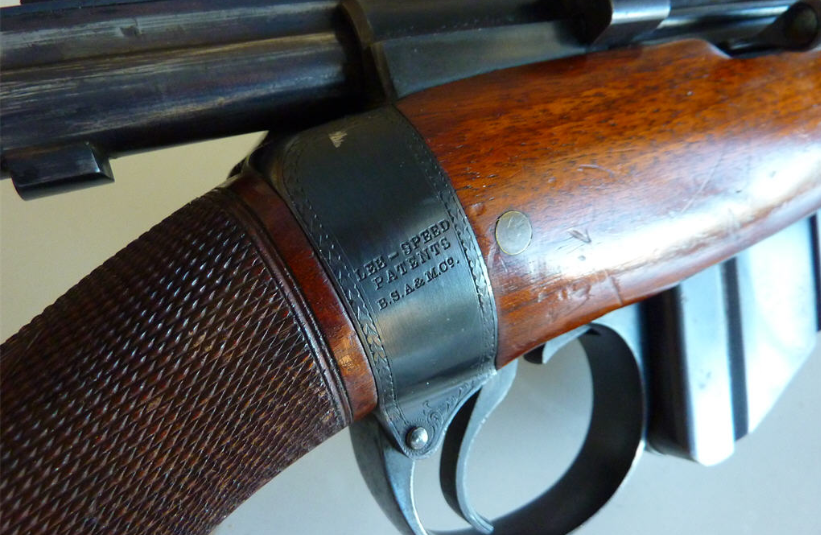
This is a sampling of some of the various BSA Lee Speeds and the differing stock and furniture that can all be considered correct. I have been fortunate in handling a few of the No 2 Pattern but even then there are subtle differences in the grip shape (depending on who made them) so I made my pattern as a compromise of the best feeling in hand.
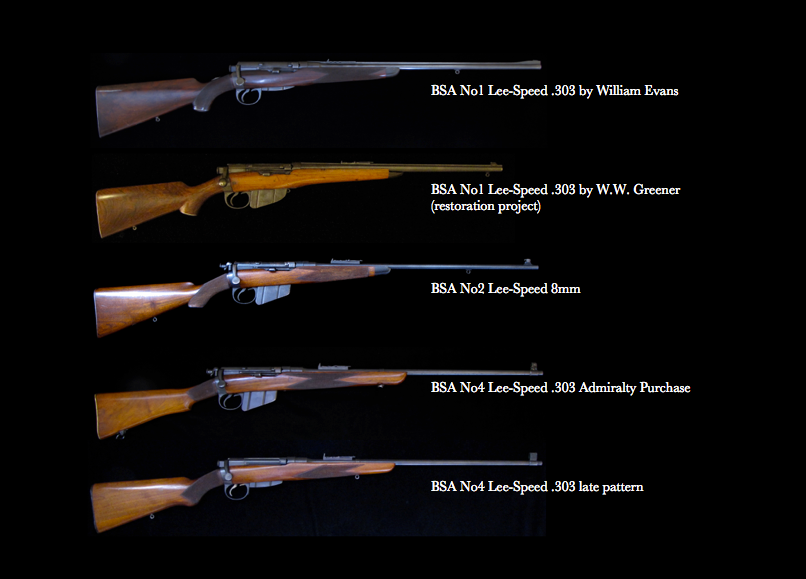
Comment
-
-
I have never seen Lee Rifles like those before. I assumed they were your rifles, "silly me" but I do like those rifles. They look very light and fast to shoulder, one of my disdains of military stocks. That time period made some of the most beautiful rifles with outstanding craftsmanship, I can see now why you are using them as a pattern. There is something about the rifles from that era that can turn a grown man into a little boy on Christmas morning Last edited by montana; 01-30-2017, 02:23 PM.
Last edited by montana; 01-30-2017, 02:23 PM.
Comment
-
-
Originally posted by 1075 tech View PostI wish I had the skill, talent, and vision (not eyesight vision) to do that work.
If I could, I'd send you my 35 year old Remington 788 18" .308 for you to restock and make a matching custom hunting knife to go with it.
I am sure it would not ne a Von Gruff quality stock with matching knife but Boyds makes some custom order walnut stocks that give the old 788's a nice facelift. One that is from a friends rifle doesn't look bad at all. That is a 788 in 222 but they will do them for other 788s.
http://i183.photobucket.com/albums/x182/rifleman55/boyds-1_zps3wh9tyw0.jpg[/img]


 [/quote]
[/quote]
Comment
-
-
I mean no disrespect with this post.
While I can apreciate that Boyds do a good stock quality wise, there are a number of points that make them look "sort of factory" to me. Depending on what the style of shooting the rifle is going to be used for would depend on the stock style and I see no advantage in a one shape fits all. Having had the opportunity to handle and study a number of between the wars rifles from the top English makers I have come to the same apreciation of the style that they used. In particular the cheekpiece style on that stock that runs into the heavy fluting seems a bit crude to me. A properly shaped wrist dose not need fluting as sliming the sides of the stock right through from the butt to the wrist make it unessesary. The wrist on a stalking rifle should be has a great effect on how fast the rifle is to mount and shoot and a thick wrist negates that ability.
I did an artical on stockmaking a few years back for a chap in South Africa to be included in a gunsmiths aprentice's manual so will post it tonight and start on the lee Speeds tomorrow night.Last edited by Von Gruff; 01-30-2017, 04:09 PM.
Comment
-
-
Von, I certainly intended no disrespect to your knowledge and abilities they far exceed mine and many others work I have seen. I apologize if my post was improper in any way.
I fully agree with you on stocks and shape as well as fit to the person does wonders for making them nimble in the hands, quicker to target and more accurate on the shot. Of all the rifles I have owned and handled the Mannlicher -Schoenauer 1903 is my favorite that stock and the buttery smooth action are hard to beat.
Comment
-
-
For thos who may have an interest in the finer points of stockmaking, this may answer a couple of points or at least be a starting place foru your own ideas on what constitutes a good hunting rifle stock.
The Rifle Stock
The Rifle Stock
By Garry Keown.
Sections.
Rifle stocks. General
Selecting your blank. Walnut species and log cuts, grain flow and blank layout)
Hunting - shooting style and design paremeters.
Balance and handling
Stock Making. Inletting and shaping.
Stock finishing. Accessories and embelishments
Rifle Stocks in general.
Rifle stocks are the simple yet ergonomically complicated means by which we can hold onto the barrelled action and direct the bullet to a desired point of impact, and so the better the stock is suited to the particular hunter, the greater the degree of certainty there is that the bullet will get to the intended target impact point. While this may seem a simplistic statement, it is anything but, as there are almost an infinite number of variations of the rifle stock, from the purest hunting designs to the specialist target and benchrest items made from the traditional wood's through to laminates of wood or layers of spaceage carbon fibres with various resins plus fiberglass either solid or over hollow core or foam base, through aluminium and combinations of one or more of these materials.
Leaving aside all the specialised rifle uses and stock materials, the hunting rifle in its more traditional form will be the focus of this piece.
What distuingishes a good hunting stock from the myriad of poor to average factory stocks( and many so called custom stocks) is for the hunter to able to throw the rifle to his (or her) shoulder and immediatly have the butt tuck into the shoulder pocket with hands comfortably griping the wrist and forearm and the eye aligned with the sights. A properly balanced rifle will have a very large degree of influence in how the rifle comes to the shoulder and onto target with a correspondingly important part to play in how pointable it may be and how steady it sits in hand. The metal work as far as the barrel contour which effects weight and balance will be explored elsewhere but does contribute to the rifle's balance, pointability, and tracking virtues ( or otherwise) so cant be entirely dismissed when the traits of a good hunting rifle stock are being discussed. There should be no adjusting of posture or position and the finger should fall naturally, without stretching or cramping, to the trigger as the target is confirmed and the shot is ready to be released. Any adjustment of body or rifle will naturally effect the initial aim point and inevitably effect the accuracy of the shot. It is the hunters responsibility to identify the target, (LEAVING NO DOUBT) before the rifle is lifted and he should already be looking at the desired point of impact when the rifle is raised and be comfortably and strategically aligned with the sights allowing him to be immediately ready to release the shot. Without getting into shooting technicalities, it is a given fact that the first few seconds of a rifles hold on target are the steadiest when shooting off hand (with no external support) so it is naturally best to have a rifle stock that gives the hunter the immediate and natural positioning of the body and the rifle so as to take advantage of this. The longer a hunter holds the rifle in the un-supported aiming position while trying to get comfortable with any aspect of the stock design, then his chances of a successful shot diminish quite rapidly. A hunter who uses an external support for the rifle, (and he would do this for a longer shot at an undisturbed animal especially if he can not stalk closer) whether it be a a sling aid or resting on a day pack, the side of a tree, a natural ground feature or a set of shooting sticks can often be well suited by a stock that is less than a perfect "fit" simply because he has time to adjust to the position. However, having said that if a rifle stock is being made for a stalking hunter, and we all like to think of ourselves as stalking hunters, then the better the rifle stock is suited to the individual hunter then the probaility of a successful hunt if a desirable animal is suddenly encountered is so much higher. This is the prime reason that hunters have had custom stocks made that fitted them properly, rather than taking one off the rack that is designed for everybody but rarely fits anyone other than with the wonderful adaptability of our body.
A rifle stock has not only to afford the hunter with a comfortable device to hold onto while aiming the barrelled action, but should also hold the barrelled action in a non movable and non stressed position so that there are no external factors that effect the point of impact for the bullet. This is another area that mass produced stocks can not always be relied on to do and so the need for a custom stock arises, or at the least customising of the factory to better accomplish the necessary primary function in a reliable manner.
This can bring about a lengthy discussion on what a custom stock actually is but for the purposes of this exercise I will define a custom stock as one that is made with the particular hunters body shape and hunting style in mind, from a billet or blank of well dried and stable stock wood.
Comment
-
-
Hunting - shooting style and design paremeters.
It may be apropriate to briefly touch on the begining of the common aproach to custom rifle stocks and rifles in general before we delve into specifics. If we leave aside the muzzle loaders and black powder cartridge rifles and concentrate on the smokless powdered cartridge bolt rifles from the turn to the first quarter of the 20th century we can look at the transition of the rifle from a military use to a purely sporting or hunting aplication. The modern rifle stock has differed little from these early stocks except for the provission of comb line to suit the predominant sighting equipment that is destined to be used.
When the first hunting rifles were produced, they were generally offshoots of military development that were initially used in the military configuration for use in the hunting fields in a protective or food gathering manner where thier somewhat heavy military style made them solidly dependable, reasonably afordable, widely available and well suited for the food suplemental purposes rather than specifically a sporting use to which they were now being put, and with the sporting amunitiion being produced, generally reliable. When they began to be adapted for the less sever conditions of the sporting hunt by very skilled craftsmen they also began to take on a svelte form that feedback was showing to be well suited to the particular hunting style of the majority of clients.
It must be understood that here I am talking of the begining of the split in the English gunmaking industry that branched from the purely military into the custom gunmakers that has left us with the famous names of the "London Trade" that are held to be the epitome of the sporting or custom rifle makers. Some of the Military rifle manufacturers like BSA in England and Mauser in Germany also had sporting rifles made in house that were adapted from the strict military style but by and large many of the custom gunmakers would buy in the barrelled action from the makers and with little or minimal metalwork being done, simply stock said barrelled actions. The Lee Speed and the Plesier Mauser were two early examples of the factory sporting rifle adapted in the makers factory for the sporting elite.
The Lee Metford military Rifle
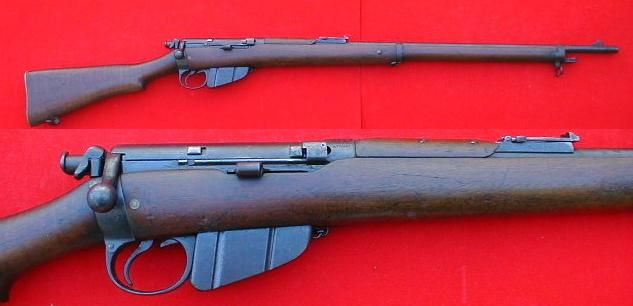
And the Lee Speed sporting rifle for the sporting gentlemen.
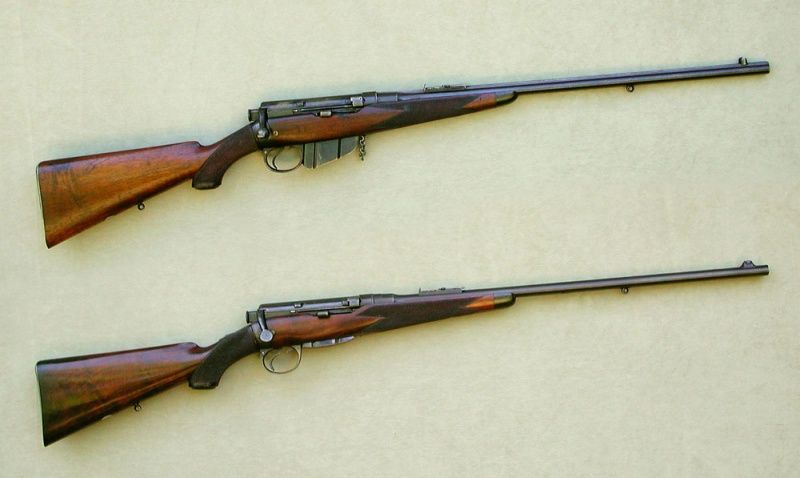

Comment
-
-
Comment
-
-
There have been other European and to a lessor extent American streams of influence in gun stock design, and while the Mauser factory continued to produce fine sporting rifles it was the English custom gunmakers who bought about the style of hunting rifle stock that has come down to todays exceptional makers who have retained many of the early findings while developing expanded design types as trends in shooting style have changed over the years.
Rigtby is one of the very best of the English gunmakers who built rifles on the 98 Mauser action.
333 Jeffery
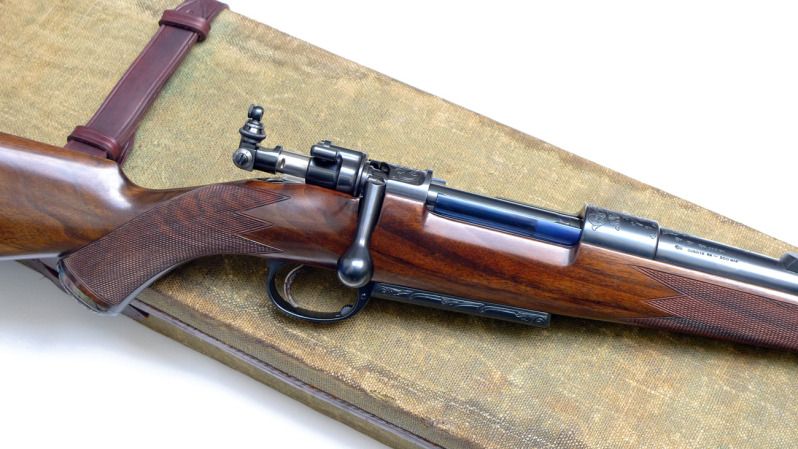
The 350 Rigby

Where once it was a walking, stalking style of hunting that required a rifle to be dimensioned for rapid shouldering and offhand shooting, where many of todays rifles are more inclined to be suited to supported shooting , from prone through to standing, and so the designs have changed in minor ways to accomadate the shooters needs with a more deliberate style of shooting becoming the norm for many.
Comment
-
-
Comment
-
-
Some terms and thier purpose in stock design are - - -
Length of pull,
Drop at comb and heel,
Pitch,
Cast,and toe
In other aspects of design like the wrist circumference and curveture, the forearm length and fullness, we get into dimensions that have a profound effect on the weight, "feel" and handling of a rifle stock but balance is often the most important as it effects the speed of mount, sight allignment and the swing. There are not as many situations today where the walking, stalking hunter may jump shoot an animal as often hunts are guided and the hunt is quite controlled in that an animal is sighted and stalked with a rested deliberate shot being taken, but a well fitted rifle is a joy to use in any circumstances. It must be said that the factory stocked rifles, while not perfect and in many cases not even very good but they all will alow a hunter a modicum of good usebility for many, the custom stock is specific to the individual.
Length of Pull.
The length of pull or distance from the centre of the butt to the centre of the trigger can greatly effect the shooter comfort and ease of use of the rifle and the general 13 1/2 L O P of factory rifles to suit the average 5 ft 10 inch tall man is the first change that is often made by altering the recoil pad thickness with or without spacers to effect a more user friendly stock length. There are a couple of broad brushstroke generalisations that are often used to find a starting point for L O P for an individual shooter. One is to take a persons height and from the suposed average 5 ft 10 with 13 1/2 L O P starting point, subtract an 1/8 inch from the L O P for every inch under 5 ft 10 of the shooters height and add an 1/8 inch to the 13 1/2 inches for every inch over 5ft 10 of shooter height. The simple expedient of holding the rifle with the arm bent at 90 degrees and having the butt in the crook of the elbow really has minimal benefit as the tendency to compromise the hold either by stretching slightly or cramping can lead to eroneous information. Then there is body shape and a heavy set shooter will have a different need than a lightly bodied one. Usually though by the time a custom stock is being contemplated, an ideal L O P has been established simply by having shot or altered previous stocks that has led to the intention of having a custom one made. The L O P also has an effect on how easily the rifle action can be worked while still held in the shooting position where too long a LOP will result in the rifle needing to be removed from the shoulder to cycle the bolt. A too short L O P may have the shooters nose smacked by his own thumb as the rifle recoiles but in general a slightly shorter L O P is more user friendly than a slightly longer one.
Drop at comb and heel.
This measurment is taken from the centre of the bore in rifles which should also be the top line of the forend of the stock as the barrelled action should ideally be inletted to half the depth of the barrel for its entire length is, so it is quite a simple matter to plot it onto the stock blank at layout time. The sighting system being used on the rifle has an effect on the line of comb and consequently, the drop at nose and heel.
Drop at comb nose is so the eye can be alligned with the sights and a simple way to start the calculation once the sighting arrangment has been decided is to find the centre of the sight height from the centre of the bore line or top of stock forearm line and note the measurment. Then take a short length of inch dowl and hold it hard under your cheekbone where a rifle stock would rest and measure from the top of the dowel up to the centre of your eye. Either you are measuring for someone else or doing it in front of a mirror so you can read the rule, if doing it for yourself. This measurement is deducted from the sight height and that should be close to the point of comb for a straight combed rifle or about two inches back from the comb nose for a stock that has more drop at heel than the nose. For example, if a bridge mounted aperture sight is being used that has the aperture an 1 1/4 above the bore line and you have a 2 inch cheekbone to centre of eye measurment then taking 1 1/4 from 2 inches means the drop at comb nose for a straight combed rifle should be 3/4 inch which nicely clears the bolt cycling on a Mauser action. The bolt throw has to be taken into account but this is usually of no concern with open sights or a low mounted scope but when the larger objective belled scopes that seem to be proliferating now are going to be used, it is then that suplementary comb extensions are added or adjustable combs incorporated into the stock to get the eye high enough and still have firm contact between cheek and stock comb. Some of the early stocks that were designed for open sights and having a scope fitted would have the particularly tall scope mounts of the time and a shooter would have to hold his face quite a way above the comb to see through the scope and while this did not make for the best results some very fine hunting rifles were equiped like this with many animals bought to grass.
The open sighted rifle will have a much different line of comb, or drop at nose and heel to a scope sighted rifle and when a shooters neck length, shoulder configuration and shooting style are added to the different types of comb line then it is evident that there can be no formulaic answer to this design paremeter. A long necked shooter with sloping shoulders will need much more drop at heel which is why the montecarlo type of comb line came to be, although almost never with open sights, while a shortnecked shooter with square shoulders will need much less drop for the same sighting system. This is where experience will be needed to ascertain the correct drop at heel for the particular shooter -rifle and cartridge combination. The least drop at heel that can comfortably allow the shooter to allign the sights will greatly effect how the rifle recoils and again depending on what cartridge the rifle is chambered for will effect how quickly the rifle action may be worked to reload another cartridge while coming down out of recoil and have the sights re-alligned for a second shot. A rifle recoils along the bore line and if this is significantly higher than the heel of the rifle will result in muzzle rise which can mitigate some of the recoild impulse and many have found this descreases the felt recoil over the same recoil in a rifle with much less drop at heel which has more straight line recoil with no rise to take some of the energy friom the shoulder. The recoil period is when the bolt can be cycled so the rifle is back on target with a fresh cartridge chambered when recoil impulse has dissipated.
Comment
-
-
Pitch
Pitch is the angle of the butt compared to the bore line and again has quite an effect on the handling of a rifle and in particular the recoil against the shoulder.
Neutral pitch is when the butt is held against a wall, the bore will be horozontal to the groundl. Negative pitch is when the toe of the stock is shorter than the heel so that the bore line is pointed toward the ground where positive pitch is where the toe is linger than the heel and so the bore line would point slightly upward from the horozontal. The reason for pitch on the butt angle is so that the greatest amount of the butt is against the shoulder pocket to spread the recoil over the greatest area and make it feel less than it would if only the toe of the stock was placed high on the shoulder and the full recoil impulse was directed through the one point of contact. Again this is where body shape is the deciding factor as is shooting style because a heavy chested man who stands upright will want some negative pitch although too much can have the butt rise up the slope of the shoulder during recoil, while the same heavy chested shooter who habitually leaned forward when shooting would need slight positive pitch. A lightly built shooter who stands upright to shoot may benifit from neutral pitch while the same shooter who leans forward to shoot may need more positive pitch than the heavy chested counterpart.
Cast.
Cast is not often incorporated into stocks now as shooting styles have changed. Broadly speaking, when the early 20 century custom stockmakers were perfecting thier craft (in England in particular) they were greatly influenced by the needs of the English sport shooter who did the majority of his shooting for small game and birds with the shotgun and while there was often rough upland shooting there was many more estate shoots that had the shooter on a stand with the birds driven toward him. This called for a certain style of shooting where he would generally be stood square to the line of drive so he could swivel left or right as needs be to take the bird on the wing or a rabbit or hare on the move. Standing square to the shot and usually quite upright for overhead shots, meant that certain design aspects were bought to the stock to ensure the quickly mounted gun was alligned with the intended target to ensure accurate tracking for instant kills of a single bird or a follow through onto a second bird for a brace. A very well fitted stock is required for this type of shooting and the stock makers understanding and expertise was carried over into the rifle stock fitting as the shooter would generally expect his rifle to handle with the same point and shoot capability when it came to game animal hunting. Cast can be either on or off and simply means the stock is shaped so that the heel is to one side or the other ot the centre line of the bore, usually dictated by the right or left hendedness of the shooter.
Cast on for a right handed shooter would have the heel of the stock to the right of the centre line of the bore when looking down on the gun is held in hand, with cast off being the opposite and having the heel to the left although this would be highly unusual.
A right handed shooter standing square to the line of shot would have cast on so that the barrels lined up straight ahead while the butt angled out toward the shoulder pocket and allowed the sight aquisition that this type of shooting dictated. Today rifle shooters are more likely to stand angled toward the line of shot so the need for cast has diminished somewhat and with the addition of cheekpieces to some stocks has resulted in almost a cast on situation so the changed shooting position and style has altered the design needs for many shooters.
Toe in or out is where the toe of the stock is placed further from the centerline of the butt and is usually worked into the stock design because it allows a heavy chested shooter ( male or female) to have a more equitable fitting of the butt to the shoulder pocket where a neutral toe might dig into the chest muscle and cause a cant to the rifle hold.
From the rear of the rifle for a right handed shooter this is the relationship of the butt to the center of barrel

Exaggerated view with that on the left being again for a right handed shooter and on the right for a left eye dominant right handed shooter.
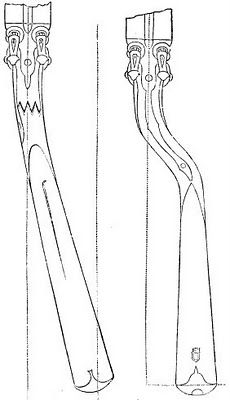
Comment
-
-
Walnut species.
Log cuts.
Selecting your blank
Walnut species.
The walnut trees that have originated in Persia came to England via the early Romans because the nut was so highly prised.The thin shelled walnut, Juglans Regia is Persian or common walnut and is also known as English walnut because of the English sailors who then spread it round the world on thier travels and so it is also known as Royal, Circassian, French, Turkish and by the place names of many other areas it has been propogated with the soil types, climate and growing conditions of many places in the new world like New Zealand and Australia producing some exceptional stockwood blanks.
American black walnut or claro is another major walnut species used for stockwood along with the English - American black walnut hybrid which is known as Bastogne from bastard walnut.
English walnut is generally known to be hard and is often thought to be more easily worked but the growing conditions have an enormous effect of the grain structure and colour, from golds through to chocolates with mineral streaking of greens and blacks, marble cake, mottling, feathered crotch, fiddleback being some of the many grain types and colourings which influences desirability and therefore price. Black and Bastogne are generally said to have a shorter and more chip prone grain structure which can make the use of English walnut and its derivitives less problematic when checkering and other finisheing touches are being atended to.
Log cuts.
The cutting of a walnut tree to get the best from the available wood is a most thought provoking process for the sawyers. There is much study of the tree to asertain where to make the initial cuts as the difference between cutting it right and just citting it can be many thousands of dollars worth of gunstocks, either superb blanks bringing out the very best the log has to offer against getting more blanks that have much less appeal and subsequent value. Logs that produce the most spectacular blanks have large root structures and heavy branches and sometimes forked trunks where the grain can have the most spectacular patterns.
A log may not be the nice round tree trunk that allows a straight forward series offcuts and very careful cutting is required on some of the very big or multifaceted logs.
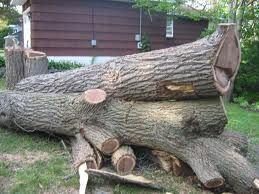
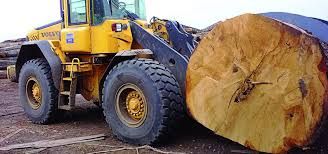
But in every case these are the essential types of grain that are gained from the log.
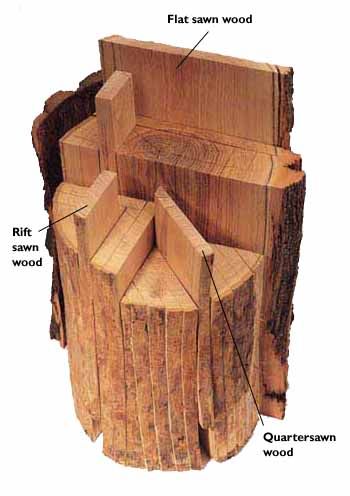
Comment
-
-
Comment
-
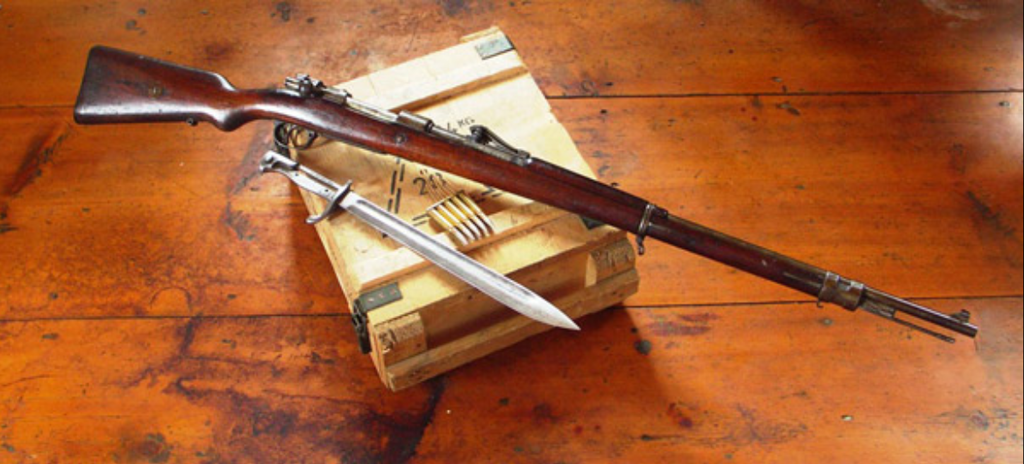

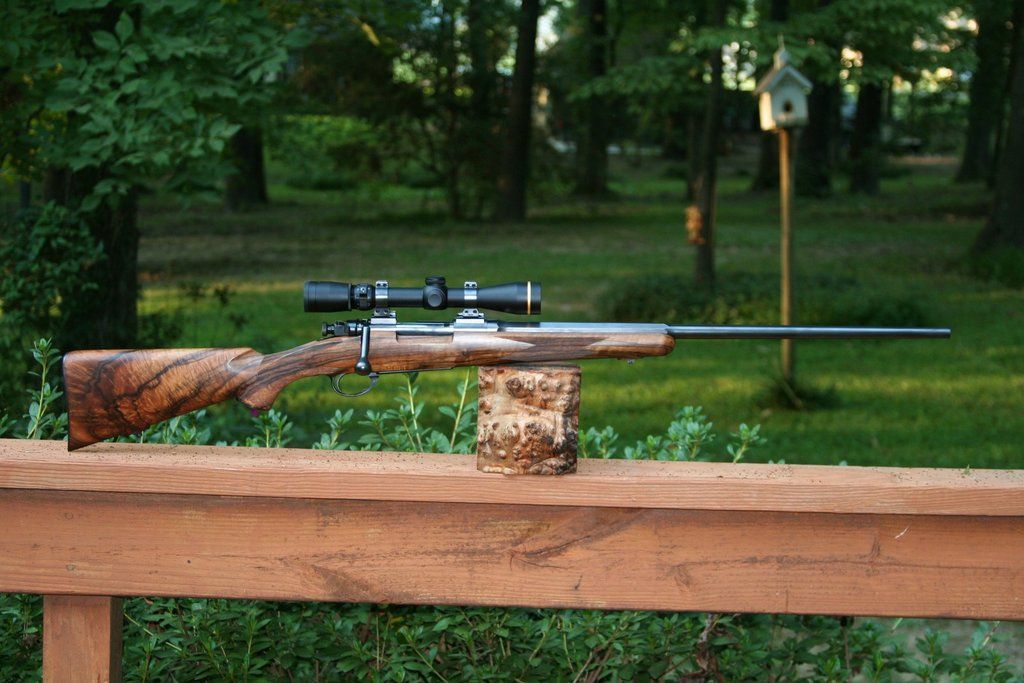
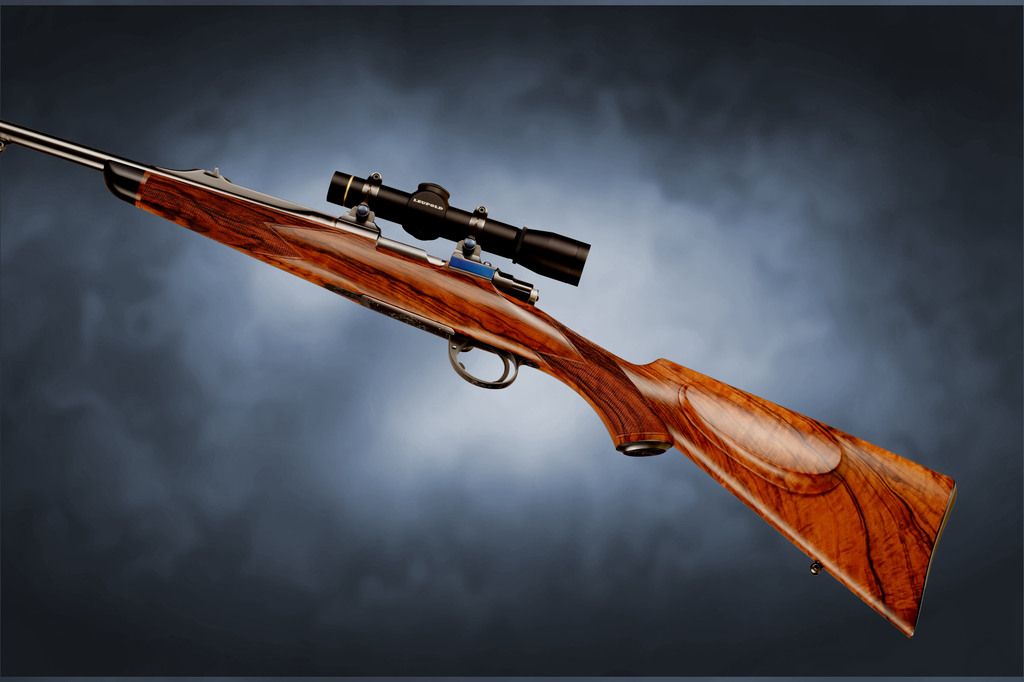
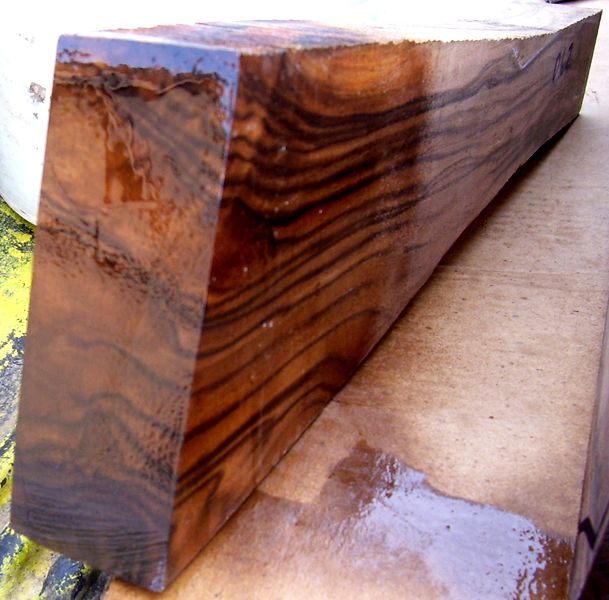
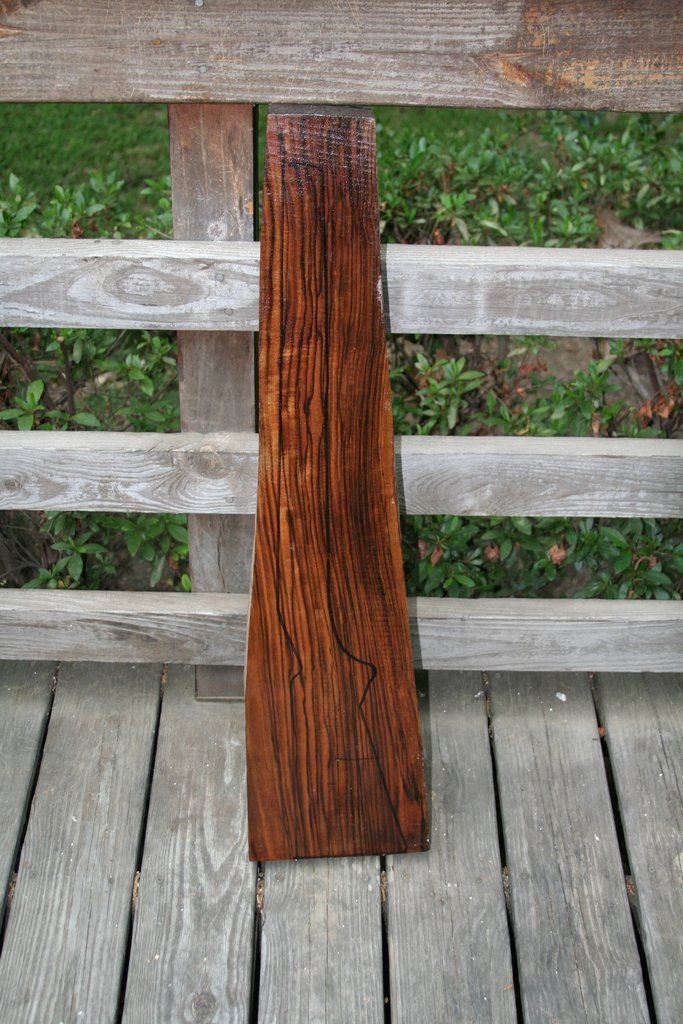
Comment